Digestion and Excretion Games
Links
Super Size Me Project Due April 8th Click here for Guidelines Coach Pease Games
Excretory System Video Excretory Video Song Click Here for a full Excretory diagram
What happens to the skeletal system when the kidneys fail? Click Here Sandoval Games
blood pumped by the heart. red blood cells More Excretory Information
Watch this video about digestion or this one or Learn more here Interactive Organs Here!
Watch a cartoon about the Digestive System Learn more about the Digestive Organs here
Humans need food, water, and oxygen to survive. Food contains energy that is processed by the body. The process by which food is broken down is called digestion. After digestion,substances that are not used by the body are removed through elimination.
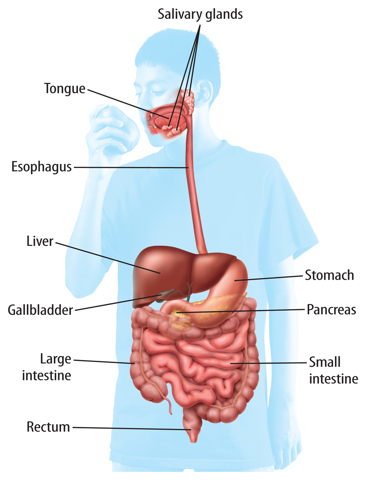
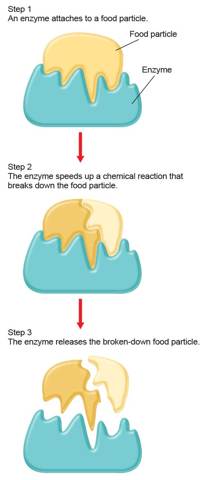
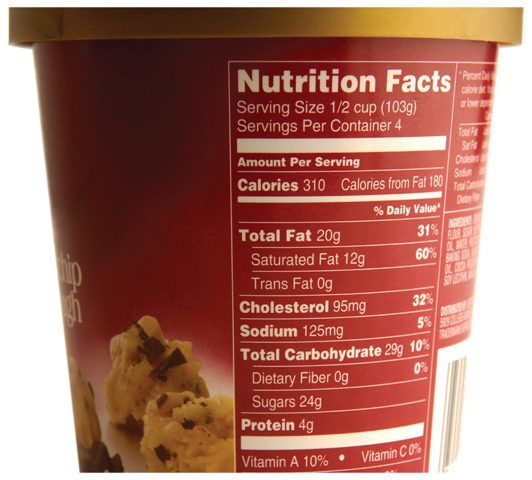
 Visual Check How many servings are in this food container?
Visual Check How many servings are in this food container?
 Why is urine yellow?
Why is urine yellow?
Some European alchemists in the middle ages apparently thought one possible reason was that there was gold in urine. This led to fruitless, and possibly quite disgusting, efforts to extract that gold.
The yellow color in urine is due to chemicals called urobilins. These are the breakdown products of the bile pigment bilirubin. Bilirubin is itself a breakdown product of the heme part of hemoglobin from worn-out red blood cells. In the bloodstream the Bilirubin is extracted by the kidneys where, converted to urobilins, it gives urine that familiar yellow tint.
Why does urine change colors? You might notice that sometimes your urine is darker in color than other times. Remember, urine is made up of water plus the waste that is filtered out of the blood. If you don't take in a lot of fluids or if you're exercising and sweating a lot, your urine has less water in it and it appears darker. If you're drinking lots of fluids, the extra fluid comes out in your urine, and it will be lighter.
Beets turn your urine pink.

Links
Super Size Me Project Due April 8th Click here for Guidelines Coach Pease Games
Excretory System Video Excretory Video Song Click Here for a full Excretory diagram
What happens to the skeletal system when the kidneys fail? Click Here Sandoval Games
blood pumped by the heart. red blood cells More Excretory Information
Watch this video about digestion or this one or Learn more here Interactive Organs Here!
Watch a cartoon about the Digestive System Learn more about the Digestive Organs here
Humans need food, water, and oxygen to survive. Food contains energy that is processed by the body. The process by which food is broken down is called digestion. After digestion,substances that are not used by the body are removed through elimination.
The Digestive System
As shown in Figure 2, the digestive system is made up of several organs. Food and water enter the digestive system through the mouth.

Hutchings Photography/Digital Light Source
Figure 2 Food enters the digestive system through the mouth, and nutrients are absorbed by the small intestine.
Digestion Before your body can absorb nutrients from food, the food must be broken down into small molecules by digestion. There are two types of digestion—mechanical and chemical. In mechanical digestion, food is physically broken into smaller pieces. Mechanicaldigestion happens when you chew, mash, and grind food with your teeth and tongue.Smaller pieces of food are easier to swallow and have more surface area, which helps with chemical digestion. In chemical digestion, chemical reactions through enzymes break down pieces of food into small molecules. Enzymes are proteins that help break down larger molecules into smaller molecules. Enzymes also speed up, or catalyze, the rate of chemical reactions.Without enzymes, some chemical reactions would be too slow or would not occur at all.
Amylase is an enzyme that helps digest carbohydrates. It is produced mainly in the pancreas and the glands that make saliva. When the pancreas is diseased or inflamed, amylase releases into the blood.
In the stomach, the enzyme pepsin functions to break proteins into smaller pieces called polypeptides. because pepsin can only break the bonds next to certain amino acids, proteins are only broken into these shorter chains, and not digested all the way to amino acids.
In the stomach, the enzyme pepsin functions to break proteins into smaller pieces called polypeptides. because pepsin can only break the bonds next to certain amino acids, proteins are only broken into these shorter chains, and not digested all the way to amino acids.
1.  Reading Check What are enzymes?
Reading Check What are enzymes?
 Reading Check What are enzymes?
Reading Check What are enzymes?
When you swallow, food, water, and other liquids move into a hollow tube called the esophagus (ih SAH fuh gus). The esophagus connects the mouth to the stomach.Digestion continues as food leaves the esophagus and enters the stomach. The stomach i sa flexible, bag like organ that contains other enzymes that break down food into smaller parts so that the food can be used by the body. Figure 3 illustrates how an enzyme helps break down food molecules into smaller pieces. Notice in Figure 3 that the food molecule breaks apart, but the enzyme itself does not change. Therefore, the enzyme can immediately be used to break down another food molecule.
2.  Reading Check Identify where food enters the body.
Reading Check Identify where food enters the body.
 Reading Check Identify where food enters the body.
Reading Check Identify where food enters the body.
Figure 3 An enzyme helps break down food molecules into smaller pieces.
Absorption Next, food moves into the small intestine. By the time food gets to the small intestine, it is a soupy mixture. The small intestine is a tube that has two functions—digestion and absorption. The liver makes a substance called bile. The pancreas makes enzymes. Both bile and enzymes are used in the small intestine to break down food even more. Because the small intestine is very long, it takes food hours to move through it.During that time, particles of food and water are absorbed into the blood.
Elimination The large intestine, or colon (KOH lun), receives digested food that the small intestine did not absorb. The large intestine also absorbs water from the remaining waste material. Most foods are completely digested into smaller parts that can be easily absorbed by the small intestine. However, some foods travel through the entire digestive system without being digested or absorbed. For example, some types of fiber, called insoluble fiber, in vegetables and whole grains are not digested and leave the body through the rectum.
Nutrition
As you have read, one of the functions of the small intestine is absorption. Nutrients are the parts of food used by the body to grow and survive. There are several types of nutrients. Proteins, fats, carbohydrates, vitamins, and minerals are all nutrients. Nutrition labels on food, as shown in Figure 4, show the amount of each nutrient in that food. By looking at the labels on packaged foods, you can make sure you get the nutrients you need. Different people need different amounts of nutrients. For example, football players,swimmers, and other athletes need a lot of nutrients for energy. Pregnant women also need lots of nutrients to provide for their developing babies.
Digestion helps release energy from food. A Calorie is the amount of energy it takes to raise the temperature of 1 kg of water by 1°C. The body uses Calories from proteins, fats,and carbohydrates, which each contain a different amount of energy.
3.  Reading Check Name five types of nutrients.
Reading Check Name five types of nutrients.
 Reading Check Name five types of nutrients.
Reading Check Name five types of nutrients.
Omikron/Photo Researchers
Figure 4 The information on a nutrition label can help you decide whether a food is healthful to eat.
 Visual Check How many servings are in this food container?
Visual Check How many servings are in this food container?
The Excretory System
The excretory system removes solid, liquid, and gas waste materials from the body. The lungs, skin, liver, kidneys, bladder, and rectum all are parts of the excretory system.
The lungs remove carbon dioxide (CO2) and excess water as water vapor when you breathe out, or exhale. The skin removes water and salt when you sweat.
The liver removes wastes from the blood. As you have read, the liver also is a part of the digestive system. The digestive and excretory systems work together to break down,absorb, and remove food.
When the liver breaks down proteins, urea forms. Urea is toxic if it stays in the body. The kidneys, shown in Figure 5, remove urea from the body by making urine. Urine contains water, urea, and other waste chemicals. Urine leaves each kidney through a tube, called the ureter (YOO ruh tur), and is stored in a flexible sac, called the bladder. Urine is removed from the body through a tube called the urethra (yoo REE thruh).
Like the liver, the rectum is part of the excretory system and the digestive system. Food substances that are not absorbed by the small intestine are mixed with other wastes and form feces. The rectum stores feces until it moves out of the body.
Excretory System (a. k. a. Urinary System)
Have you ever wondered why your body has to urinate? Where does that fluid come from? Why is it yellow? You'll learn the answers to these and more questions as you read our information about the excretory system. Video Song
Parts of the Excretory System
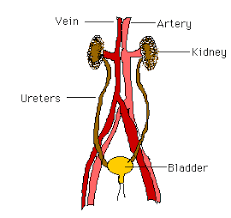 the kidneys: they contain filters that take the waste out of the blood
the kidneys: they contain filters that take the waste out of the blood
the nephrons: remove the waste materials from blood and make urine
the ureters: tubes that carry the urine to the bladder
the bladder: a 'bag' that collects the urine
the urethra: a tube that carries the urine out of the body
What does the excretory/urinary system do?
The kidneys, the bladder, and their tubes all work together to form the urinary system. Waste that's left over from breaking down food and your body's other activities naturally builds up in your blood. Your blood passes through your kidneys and when this happens, your kidneys act like a filter to clean the waste from your blood. Then they mix the waste with a little water to create urine. The urine goes to your bladder, which you empty when you urinate (pee). Kidneys and Nephrons
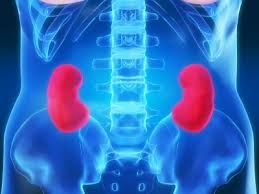 One of the main jobs of the kidneys is to filter the waste out of the blood. First, blood is carried to the kidneys by the renal artery. As the blood passes through the kidneys, it deposits used and unwanted water, minerals, and a nitrogen-rich molecule called urea. More than 1 million tiny filters inside the kidneys remove this waste. These filters, called nephrons, are so small you can see them only with a high-powered microscope.
One of the main jobs of the kidneys is to filter the waste out of the blood. First, blood is carried to the kidneys by the renal artery. As the blood passes through the kidneys, it deposits used and unwanted water, minerals, and a nitrogen-rich molecule called urea. More than 1 million tiny filters inside the kidneys remove this waste. These filters, called nephrons, are so small you can see them only with a high-powered microscope.
Kidneys normally come in pairs. If you've ever seen a kidney bean, then you have a pretty good idea what the kidneys look like. Each kidney is about 5 inches long and about 3 inches wide.
Ureter, Bladder and Urethra The waste that is collected combines with water (which is also filtered out of the kidneys) to make urine. As each kidney makes urine, the urine slides down a long tube called the ureter and collects in the bladder, a storage 'bag' that holds the urine. When the bladder is about halfway full, your body tells you to go to the bathroom. When you urinate, the urine goes from the bladder down another tube called the urethra and out of your body.
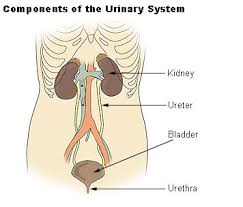
If the urinary system is healthy, the bladder can hold up to 16 ounces (2 cups) of urine comfortably for 2 to 5 hours.
What happens to the skeletal system when the kidneys fail? Click Here
More about the kidneys...
Although the kidneys are small organs by weight, they receive a huge amount -- 20 percent -- of the blood pumped by the heart. The large blood supply to your kidneys enables them to do the following tasks:
Fun Facts
Interesting Stuff....
5. The average person poops about 305 pounds a year.
6. The liver is rubbery to touch.
Excretory System (a. k. a. Urinary System)
Parts of the Excretory System
the nephrons: remove the waste materials from blood and make urine
the ureters: tubes that carry the urine to the bladder
the bladder: a 'bag' that collects the urine
the urethra: a tube that carries the urine out of the body
What does the excretory/urinary system do?
The kidneys, the bladder, and their tubes all work together to form the urinary system. Waste that's left over from breaking down food and your body's other activities naturally builds up in your blood. Your blood passes through your kidneys and when this happens, your kidneys act like a filter to clean the waste from your blood. Then they mix the waste with a little water to create urine. The urine goes to your bladder, which you empty when you urinate (pee). Kidneys and Nephrons
Kidneys normally come in pairs. If you've ever seen a kidney bean, then you have a pretty good idea what the kidneys look like. Each kidney is about 5 inches long and about 3 inches wide.
Ureter, Bladder and Urethra The waste that is collected combines with water (which is also filtered out of the kidneys) to make urine. As each kidney makes urine, the urine slides down a long tube called the ureter and collects in the bladder, a storage 'bag' that holds the urine. When the bladder is about halfway full, your body tells you to go to the bathroom. When you urinate, the urine goes from the bladder down another tube called the urethra and out of your body.
If the urinary system is healthy, the bladder can hold up to 16 ounces (2 cups) of urine comfortably for 2 to 5 hours.
What happens to the skeletal system when the kidneys fail? Click Here
More about the kidneys...
Although the kidneys are small organs by weight, they receive a huge amount -- 20 percent -- of the blood pumped by the heart. The large blood supply to your kidneys enables them to do the following tasks:
- Regulate the composition of your blood: Keep the concentrations of various ions and other important substances constant; Keep the volume of water in your body constant; Remove wastes from your body (urea, ammonia, drugs, toxic substances); Keep the acid/base concentration of your blood constant
- Help regulate your blood pressure
- Stimulate the making of red blood cells
- Maintain your body's calcium levels
Fun Facts
Interesting Stuff....
1. Our blood passes through our kidney's 300 times a day.
2. our nephrons can clean our blood within 45 minutes.
3. Everyday our nephrons send 6 cups of urine to our bladder.
4. The average person pees about 3000 times a year. 2. our nephrons can clean our blood within 45 minutes.
3. Everyday our nephrons send 6 cups of urine to our bladder.
5. The average person poops about 305 pounds a year.
6. The liver is rubbery to touch.
Some European alchemists in the middle ages apparently thought one possible reason was that there was gold in urine. This led to fruitless, and possibly quite disgusting, efforts to extract that gold.
The yellow color in urine is due to chemicals called urobilins. These are the breakdown products of the bile pigment bilirubin. Bilirubin is itself a breakdown product of the heme part of hemoglobin from worn-out red blood cells. In the bloodstream the Bilirubin is extracted by the kidneys where, converted to urobilins, it gives urine that familiar yellow tint.
Why does urine change colors? You might notice that sometimes your urine is darker in color than other times. Remember, urine is made up of water plus the waste that is filtered out of the blood. If you don't take in a lot of fluids or if you're exercising and sweating a lot, your urine has less water in it and it appears darker. If you're drinking lots of fluids, the extra fluid comes out in your urine, and it will be lighter.
Beets turn your urine pink.
4. Key Concept Check How does food enter and leave the body?

Figure 5 The kidneys remove waste material from the body.
Lesson Review
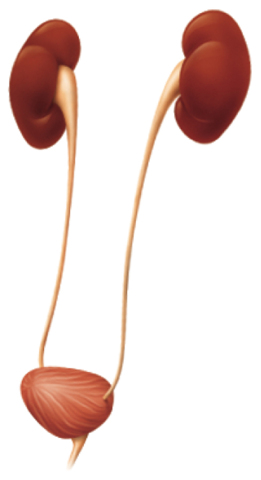

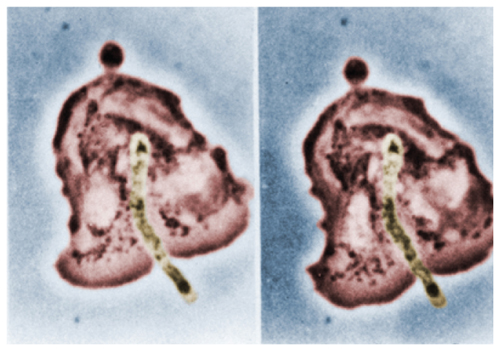
Critical Thinking
Visual Summary
The kidneys remove liquid wastes from the body.

The circulatory system transports nutrients, gases, wastes, and other substances through the body.

Immune cells detect and destroy viruses, bacteria, and other foreign substances.

Omikron/Photo Researchers
What do you think NOW?
You first read the statements below at the beginning of the lesson.
1. A human body has organ systems that carry out specific functions.
2. The body protects itself from disease.
Did you change your mind about whether you agree or disagree with the statements?Rewrite any false statements to make them true.
Lesson Assessment
Use Vocabulary
1. Use the term organ system in a sentence.
2. Define homeostasis in your own words.
3. A(n) __________ is a type of white blood cell.
Understand Key Concepts
4. Organs are groups of __________ that work together.
A.cells
B.organisms
C.systems
D.tissues
5. Compare and contrast mechanical and chemical digestion.
6. Differentiate the role of the liver in the digestive system from its role in theexcretory system.
7. Examine how the circulatory system and the respiratory system work together andmove oxygen
through the body.
through the body.
8. Contrast infectious diseases and noninfectious diseases.
9. Which body system removes carbon dioxide and waste?
A.circulatory
B.digestive
C.excretory
D.lymphatic
10. Which body system makes immune cells?
A.circulatory
B.digestive
C.excretory
D.lymphatic
11. Which are bundles of cells in the lungs that take in oxygen?
A.alveoli
B.bronchi
C.nostrils
D.trachea
12. Which are proteins that recognize specific proteins on bacteria?
A.antibodies
B.enzymes
C.nutrients
D.receptors
13. Which is NOT a type of blood vessel?
A.artery
B.capillary
C.spleen
D.vein
Interpret Graphics
14. Analyze the nutrition label below. How many Calories, carbohydrates, fats, and proteins are in a
serving of this food?

serving of this food?

Mark Steinmetz
15
.
Summarize Copy and fill in the graphic organizer below to show how food travels through the
digestive system.

digestive system.

Critical Thinking
16. Describe the roles of the structure shown below in digestion.
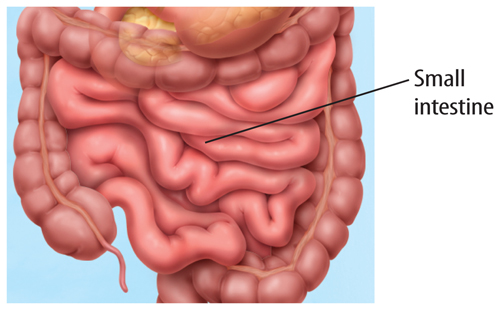

17. Compare the functions of lymphatic vessels and blood vessels.
18. Predict how your daily life would change if your skin contained no melanin.
19. Evaluate how the skin’s ability to continually produce new skin cells helps protectyour body.
20. Relate the organs of the lymphatic system to immunity.
21. Identify the main functions of the digestive, excretory, respiratory, circulatory, and
integumentary systems.
integumentary systems.
Writing in Science
22. Write a five-sentence paragraph that distinguishes the two main types ofdiseases. Be sure to
include a topic sentence and a concluding sentence in your paragraph.
include a topic sentence and a concluding sentence in your paragraph.
Math Skills
Use Proportions
23. If 30.5 g of milk contains 18 C, how many Calories will you consume by drinking a glass of milk
(244 g)?
(244 g)?
24. Which type of chicken in the table below has the fewest Calories per gram?


25. A small 140g apple and a 100g banana each provide 70 C of energy. How many Calories would there be in a 200g- serving of fruit salad that contained equal amounts of apple and banana?
[Hint: Add the values for the apple and the banana first.]
[Hint: Add the values for the apple and the banana first.]
Copyright © 2011-2012 The McGraw-Hill Companies. All Rights Reserved.
Texas Essential Knowledge and Skills Copyright © 2011. Texas Education Agency. All Rights Reserved.
Texas Essential Knowledge and Skills Copyright © 2011. Texas Education Agency. All Rights Reserved.
No comments:
Post a Comment